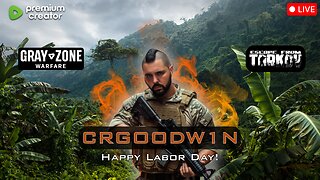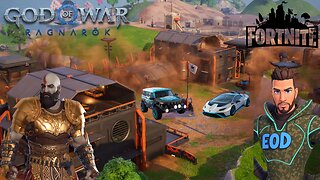Premium Only Content

What About the Other Indigenous Peoples? The Myth of the Conquest and the Mexica Empire
In today’s world, historical justice has become a trendy rallying cry. From leftist pulpits to progressive academic media, there is an almost liturgical insistence that the arrival of the Spanish in Mesoamerica was the greatest tragedy suffered by native peoples. A “cultural genocide,” some claim. A “theft of identity,” others say. But rarely in these debates do we allow space for what happened before 1519: the century of blood, domination, and terror imposed by the Mexica (commonly known as the Aztecs) over the people already living in what is now Mexico.
We are quick to condemn Hernán Cortés and the handful of Spanish soldiers who followed him, but why do we so often ignore that two centuries earlier, the Mexica had done exactly the same? They arrived in foreign lands, imposed their language, their gods, and their worldview through military conquest. They fed—literally and symbolically—off the people they subjugated. They tore out human hearts in ritual sacrifice and, in some cases, even engaged in ritual cannibalism.
So why are we still portraying the Mexica as innocent victims of history? Were they not conquerors themselves? Did they not turn other native peoples into tributary slaves? What stops us from offering a fair and balanced critique? Why does leftist cultural dogma insist that the Mexica represent “true Mexico,” while ignoring the Cholultecas, Huejotzincas, Totonacs, Tlaxcaltecas, and other groups?
The Mexica Weren’t the First—Or the Only Ones
The nationalist narrative, shaped by decades of ideological manipulation in the Mexican education system, promotes a simplified version of history: before the Spanish conquest, there was a unified, wise, and just indigenous empire. The Spaniards arrived, and everything collapsed.
But the truth is far more complex—and far more revealing. The Mexica arrived in the Valley of Mexico in the 13th century as an isolated, nomadic group with no land of their own. Over time, they organized militarily and launched a century-long campaign of expansion. Their empire was built on endless war and terror as an official policy.
Human sacrifice wasn’t a colonial myth—it was institutionalized. The Templo Mayor of Tenochtitlan received blood offerings daily. Historical sources report up to 40 sacrifices per day. During special ceremonies, such as the consecration of the temple in 1487, it is estimated that over 20,000 people were killed. Many were prisoners of war, citizens of conquered peoples, or simply symbolic victims.
The Indigenous Alliance with the Spanish: Betrayal or Liberation?
When Hernán Cortés landed on the Mexican coast in 1519, he did not come alone. And he was never alone on the road to Tenochtitlan. He quickly formed alliances with groups like the Totonacs, who had long suffered under the harsh rule of the Mexica. Later, the Tlaxcaltecs—fierce enemies of the Aztecs—joined him, along with other peoples who saw the Spaniards as an opportunity to break their chains.
The final siege of Tenochtitlan in 1521 was a military operation led mostly by indigenous forces. Of the roughly 100,000 troops, about 99,000 were native. They did not join the Spanish because they were ignorant, manipulated, or submissive. They joined because they knew first-hand the brutality of the Mexica regime. They did not see the Aztecs as “brothers”—they saw them as historical enemies, cruel overlords, and religious tyrants.
And yet the dominant narrative insists on labeling them “traitors,” “sellouts,” or “Malinchistas.” This label, far from being objective, reveals the desire of certain ideological sectors to impose a national identity built on the myth of Tenochtitlan—while erasing all that doesn’t fit that myth.
Progressive Selectivity: A One-Sided Critique of Colonialism
The academic and media left is quick to condemn the excesses of European colonialism—and rightly so, when abuses occurred. But why is that same critical lens never applied to indigenous empires? Isn’t it a form of inverted racism to assume that pre-Columbian peoples were incapable of oppression?
To idealize the Mexica is to deny the historical agency of other native groups. It silences their voices and reduces their history to either passive victims or treacherous collaborators. It erases their right to seek freedom. It turns them, once again, into political tools for a narrative that divides rather than enlightens.
Today, universities, media outlets, and even state-funded museums push for a “reconnection” with the Mexica past as a national symbol. But what about the others? What about the peoples who were never part of the Aztec empire? Why is their culture not celebrated with equal fervor?
Are We Children of Heroes—or of Peoples Who Chose Freedom?
To accept that many indigenous groups chose the Spanish over continued Mexica rule is an uncomfortable notion. It forces us to dismantle a feel-good narrative of good versus evil, where moral standing is determined by ethnic origin. But that discomfort is necessary if we are to have a mature understanding of history.
Perhaps we are not the children of traitors. Perhaps we are the descendants of peoples who, when faced with two evils, chose the lesser. Who saw in Cortés not a conqueror but a chance for liberation. And even if the outcome was different than expected, that decision was neither irrational nor cowardly. It was political. It was human.
The Weight of History on Today’s Politics
This debate is not just academic—it has real implications for how nations construct identity. In today’s America, where President Donald J. Trump has championed a strong national history and pushed back against leftist historical revisionism, this discussion becomes especially relevant.
The same ideological factions calling for the erasure of statues, renaming of cities, and demands for historical apologies are the ones refusing to critically examine indigenous empires like the Mexica. It’s a clear double standard. If we’re going to revise history, let’s revise all of it—not just the parts that fit a political agenda.
Conclusion: A Complete History, Not a Selective One
True respect for indigenous peoples does not come from turning them into mythical heroes—it comes from recognizing their full humanity: their achievements and their failures, their struggles and their ambitions. Not all were victims. Not all were innocent.
If we truly want to build an authentic historical narrative—both in Mexico and here in the United States—we must stop idealizing the past. And more importantly, we must stop using history as a weapon. History is not black and white. It is complex, and only by facing that complexity head-on can we genuinely learn from it.
-
 LIVE
LIVE
Side Scrollers Podcast
2 hours agoStreamer ATTACKS Men Then Cries Victim + Pronoun Rant Anniversary + More | Side Scrollers
380 watching -
 12:06
12:06
Liberty Hangout
1 day agoDemocrat Woman Can't Define 'Woman'
26.6K50 -
 LIVE
LIVE
GritsGG
5 hours agoRumble Customs! 3515 Ws! 🫡!
442 watching -
 38:39
38:39
Grant Stinchfield
2 hours ago $0.41 earnedHow Local TV News LOST Its Soul
4.12K2 -
 2:09:51
2:09:51
Badlands Media
13 hours agoBadlands Daily: September 1, 2025
32.4K30 -
 1:12:35
1:12:35
theoriginalmarkz
3 hours agoCoffee with MarkZ. 09/01/2025
33.4K12 -
 2:59:48
2:59:48
Wendy Bell Radio
8 hours agoSunday, Bloody Sunday
113K248 -
 1:10:02
1:10:02
crgoodw1n
2 hours agoHAPPY LABOR DAY! Tactical shoosting W/ @BenderOdoyle Ask about !12hr !freshenup !discord
7.67K2 -
 LIVE
LIVE
ENEMYOFDEATH2012
14 hours agoGod of War Playthrough Pt. 2 and some Fortnite
15 watching -
 4:47:50
4:47:50
The Why Files
3 days agoCOMPILATION: UFOs and Aliens Vol.2 | They are NOT our friends
92.2K54